To celebrate this year’s International Women’s Day, museum supporter Jane Kilsby wanted to share the story of locally born Landscape Architect Dame Sylvia Crowe, CBE 1901-1997.
Dame Sylvia Crowe was a pioneering Landscape Designer, Business Women, Author, Chelsea Flower Show Gold Medal Winner and World War II Ambulance Driver to name just a few of her achievements.
She was elected President of the Institute of Landscape Architects in 1957 and is widely known for her work integrating landscape architecture into 20th Century infrastructure and urban planning schemes.
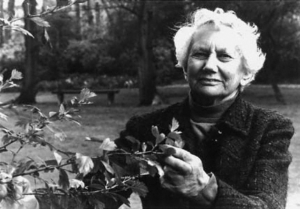
Image Credit: Banbury Guardian
Early life, Family and Education
Sylvia Crowe was born at 30 Oxford Road, Banbury on 15th September 1901. Her father
was Eyre Crowe, a box and cabinet maker. Her mother was Beatrice Stockton, a member
of the Stockton family of solicitors. Beatrice Stockton was one of the first women to be
educated at the University of Oxford. Three members of the Stockton family served as
Town Clerk of Banbury Borough Council in the first half of the 20th century.
Her parents’ house in Banbury was demolished when Oxford Road was widened in the
1930s.
The family moved to Felbridge near East Grinstead during Sylvia’s early childhood. Her
father had a respiratory illness and bought a fruit farm. As a child Sylvia also had some
illness and was largely home-schooled by her mother.
Later, aged 19, Sylvia studied at Swanley Horticultual College. She then ran her own fruit
growing business in Surrey and travelled extensively before starting her own garden and
landscape design company.
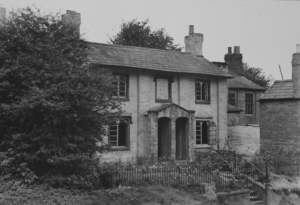
30 Oxford Road, left. The Crowe family home in Banbury.
Image Credit: Oxfordshire History Centre
Sylvia Crowe’s Career and Achievements
In 1937 she won a gold medal at the Chelsea Flower Show. and by 1939 she had been elected to the council of the Institute of Landscape Architects. She was also involved with the International Federation of Landscape Architects and was later engaged on projects overseas.
During World War II she joined the First Aid Nursing Yeomanry and became an ambulance driver for a Polish brigade in northern France, being part of the withdrawal from Paris with the advance of the German forces. On returning to England, she served with the Auxiliary Territorial Service and was promoted to Sergeant.
She then moved to London and resumed her work in landscape design, sharing an office with another accomplished landscape architect, Brenda Colvin. Her early works showcased a commitment to integrating natural elements into urban spaces, emphasizing the importance of greenery and open spaces in enhancing the quality of life for urban dwellers. She was asked to advise on the rebuilding of urban areas becoming particularly adept at making power stations, nuclear power stations, reservoirs and other such new industrial installations sit well within their surroundings. She completed several commissions for
organisations such as the Central Electricity Generating Board. Examples of her larger post-war projects were the landscape development of Harlow and Basildon new towns in Essex and Rutland Water.
Her work was successfully integrating 20th century infrastructure – motorways, reservoirs, nuclear power stations, hospitals – into the British countryside. Her contribution was often unnoticed: where the public could not really see that a landscape architect had been at work.
‘It should be the aim of each of us to leave our chosen corner not more vulgar, but lovelier and more dignified after we have gone’
Domestically Sylvia was noted for her inclusion of water features and sculptures within her schemes, and particularly for her ability to create private, compartmentalised areas in even the smallest gardens. Her schemes took into consideration the natural landscape, the ability to create views and vistas, and the overall character of the area to be developed.
In her work with the Forestry Commission she advised on planting schemes for vast tracts of woodland, especially in Scotland, and was appointed chairman of the Tree Council for her work with them. She encouraged the Forestry Commission to use mixed trees rather than rows of conifers in their plantations and planted alder and rowan for deer to rub their horns on.
She served a term of office as president of the Institute of Landscape Architects between 1957 – 1959, and was the Architects’ Journal “Woman of the Year” in 1990. In the same year, she earned the Royal Horticultural Society’s Victoria Medal of Honour, to add to her many other national and international awards.
Sylvia wrote several books that are considered still relevant to today’s designers and architects and seen as classics within the discipline. The Landscape of Power (1958), explored the relationship between power structures and the design of landscapes.
Crowe’s intellectual contributions extended beyond her practical projects, as she became an advocate for the integration of landscape architecture into broader urban planning initiatives. She took in students, from Europe and the USA, who were trained in the skills necessary for landscape design, and was very involved with the ILA’s examination and Education Board. She was awarded a CBE in 1967 and created Dame in 1973.
The Banbury Connection
Through her mother, Sylvia Crowe was related to the Stockton family. The Stocktons were prominent and well-repected solicitors and public servants in Banbury. James Stockton (1827-1899) set up a practice in partnership with William Munton and the firm later became Stockton, Sons and Fortescue and then Aplin, Stockton and Fairfax. James Stockton and his sons were Town Clerks and oversaw the considerable expansion of the town in the early to mid 20th century.
While her home as an adult was in London, Sylvia Crowe retained her connections with Banbury throughout her life. Her funeral was held at St Mary’s Church in 1997 and she is buried at Hardwick Hill Cemetery.
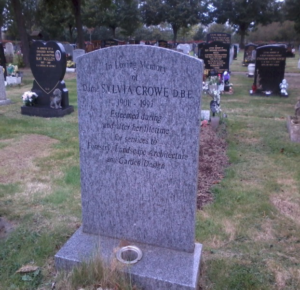
Image Credit: Jane Kilsby 2019
St Mary’s Churchyard
She was commissioned by Banbury Borough Council to refurbish St Mary’s Churchyard (described as the dirtiest in England). Her work was completed in 1953 and the churchyard has not been changed much since then. Dame Sylvia’s design included the moving of several of the gravestones so that they stand against the side walls of the church or form part of the paths.
While this caused some controversy at the time, her design and its implementation was a radical change and a considerable improvement for Banbury. For the first time in decades residents could enjoy walking through the churchyard. She planted the white magnolia at the front of the church. The stone flower boxes and the clear paths through the churchyard were also part of her design.
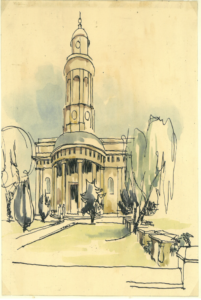
Illustrations by Christine Moller
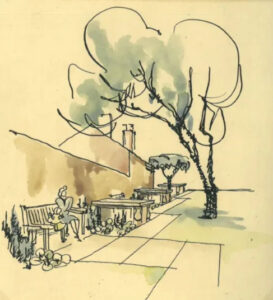
Used with kind permission from The Museum of English Rural Life.
Tree Planting Schemes
Banbury Borough Council commissioned Sylvia Crowe for their new housing estates in the late 1940s and 1950s. She completed a tree planting scheme for a number of the new residential streets including The Fairway, Cherry Road and Ferndale Road. Significantly she also included a shelter belt on the western boundary of the new estates leading off Warwick Road. It included several groups of native trees and hedges.
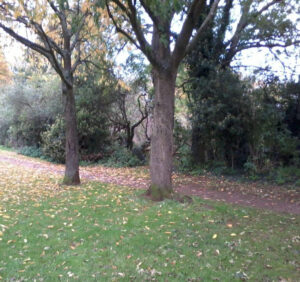
Trees near to William Morris School – this is part of the shelter belt to what was then the west boundary of the Warwick Road Estate.
Image Credit: Jane Kilsby 2019

Hornbeams in Ferndale Road. Ferndale Road was completed in 1948-49.
Image Credit: Jane Kilsby 2019
Key Works & Further Reading
Podcast and article by The Architectural Review
AR Reads: Sylvia Crowe – The Architectural Review
Sylvia Crowe (1901-1997) – The Architectural Review
Sylvia Crowe: innovator and exemplar by Ken Taylor
SC edited by G Collins.pdf
University of Newcastle Upon Tyne
D Litt S.Crowe
Sylvia Crowe newcastle.pdf
Key Works
Lower Soughton Hall, Northop, Flintshire, 1937
Commonwealth Institute, London, 1962
Trawsfynydd Nuclear Power Station, Wales, 1959-63
Rutland Water Reservoir, East Anglia, 1976
Scottish Widows Fund and Life Assurance HQ, Edinburgh, 1976
Commonwealth Gardens, Canberra, 1977
About the Author:
Jane Kilsby has a background in public sector housing management. In moving to Banbury in 2013, she became interested in some of Banbury’s unsung heroes. She became aware of Dame Sylvia Crowe in working on the People’s Park centenary celebrations in 2019. Jane thinks that Dame Sylvia’s career and spectacular contribution to national and international landscape architecture should be remembered and commemorated in her home town.
